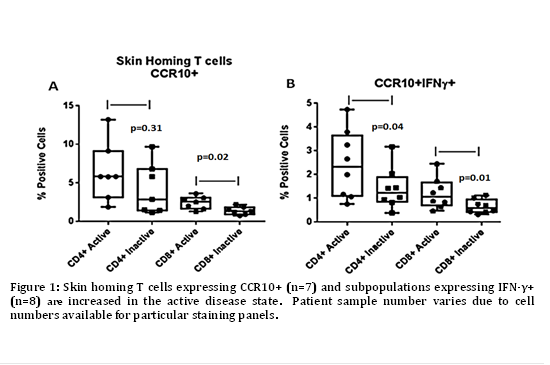Session Information
Date: Monday, November 6, 2017
Session Type: ACR Poster Session B
Session Time: 9:00AM-11:00AM
Background/Purpose:
Localized scleroderma (LS) has both inflammatory and fibrotic components contributing to its effect on the skin and underlying tissue. The understanding of the pathophysiology driving this process is limited, though there is evidence supporting T cell involvement in both systemic sclerosis (SSc), its related disease, and LS. Recent studies in SSc have focused on skin homing T cells in the circulating peripheral blood which may be directly contributing to disease progression and skin inflammation with subsequent fibrosis (1). We aim to study this same concept in LS and investigate skin homing cells that may contribute to skin inflammation and reflect activity at lesion sites.
Methods:
PBMCs were isolated from 10 pediatric LS subjects with paired active/inactive blood specimens (20 samples total), and were analyzed at rest and after PMA/ionomycin stimulation. Flow cytometry was performed to characterize T cells using antibodies for T cell subsets (CD3, CD4, CD8, CD28), T memory cells (CD45RO), T trafficking and adhesion (CXCR3, CCR4, CCR6, CD62L), and skin homing cells (CCR10 and CLA). Selected intracellular TH1 and TH2 cytokines (IFN-γ, TNF-α, and IL-13) were also measured. Cell populations were compared between LS active and inactive disease states using paired Wilcoxon Signed-Ranks Test.
Results:
The proportion of CD4+ (TH) and CD8+ (TC) T cells among total PBMC were not significantly different between active and inactive disease states. However, there was a significant increase in the proportion of skin homing CCR10+ TC (Fig.1A) in samples collected during active disease. In addition, both CCR10+ TC and CCR10+ TH cells produced inflammatory cytokine populations, IFN-γ, that were significantly increased in the active disease state compared to the inactive disease state (Fig 1B).
Conclusion:
This is one of the first studies to examine circulating cell immunophenotypes in pediatric-onset localized scleroderma, with emphasis on examining the association of T skin homing cell subtypes with disease activity. These findings suggest increased skin homing (CCR10+) of inflammatory cytokine producing subpopulations of TC and TH cells in active disease (Fig 1). In adult SSc, IL-13+, and not IFN-γ+, CD8+CCR10+ cells appear to be the skin homing cell type that propagates disease (1), emphasizing possible biological differences in scleroderma phenotypes; more inflammatory, TH1/TC1 phenotype in LS and the more fibrotic, TH2/TC2 phenotype, in SSc. Determining active disease status in patients with scleroderma may allow targeting of key immune components to prevent damage and disfigurement.
References:
(1) Li G, Larregina AT, Domsic RT, Stolz DB, Medsger TA, Jr., Lafyatis R, Fuschiotti P. Skin-Resident Effector Memory CD8+CD28- T Cells Exhibit a Profibrotic Phenotype in Patients with Systemic Sclerosis. J Invest Dermatol. 2017;137(5):1042-50.
To cite this abstract in AMA style:
Macaubas C, Mirizio E, Schollaert-Fitch K, Mellins ED, Torok KS. Interferon Gamma (IFN-γ) Subpopulations in Skin Homing T Cells of Localized Scleroderma [abstract]. Arthritis Rheumatol. 2017; 69 (suppl 10). https://acrabstracts.org/abstract/interferon-gamma-ifn-%ce%b3-subpopulations-in-skin-homing-t-cells-of-localized-scleroderma/. Accessed .« Back to 2017 ACR/ARHP Annual Meeting
ACR Meeting Abstracts - https://acrabstracts.org/abstract/interferon-gamma-ifn-%ce%b3-subpopulations-in-skin-homing-t-cells-of-localized-scleroderma/

